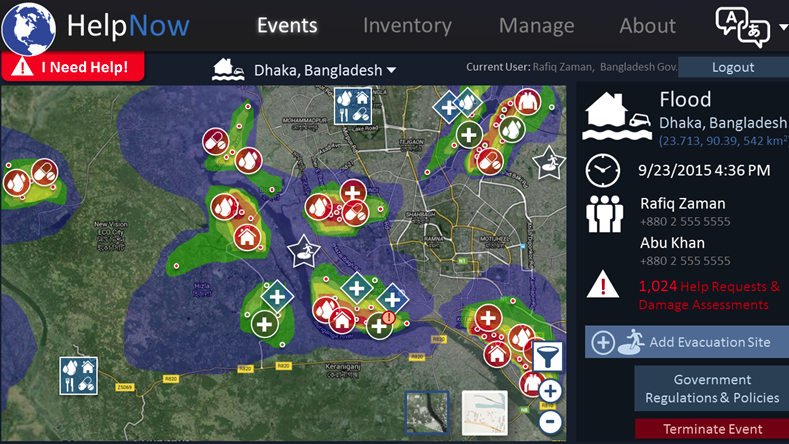Colorado aerospace technology workers have created software to help speed relief to victims of natural disasters around the world.
Workers at Jefferson County-based Lockheed Martin Space Systems Co. (LMSS) built the HelpNowMap.com service to help get clear data to residents, first-responders and aid agencies on the ground after floods, earthquakes, hurricanes and other disasters around the world.
Now they hope a major aid agency takes up the technology and software developers elsewhere continue to flesh it out.
The volunteer effort is an outgrowth of needs identified by the World Economic Forum’s Global Council Agenda on Space, on which LMSS head Rick Ambrose served as chairman of in 2015.
Volunteer technologists at the company quickly realize that disaster relief agencies often lacked a centralized, real-time software platform that could collect the scarce data available immediately after a disaster, take in new information about damage and the needs of victims and make useful to relief agencies on the ground.
Christina Bain, a systems engineer at LMSS who works on the company's program creating NASA’s Orion space capsule, immediately volunteered work on what became HelpNow.
She lived outside New Orleans, working for LMSS, 11 years ago when Hurricane Katrina hit and devastated the Gulf Coast.
Her home got water up to the door knobs and she had to evacuate. Bain said she fared well compared to thousands of others, but the experience left insights about what it’s like to live in a disaster zone.
“You wonder where you’re going to get food, where you’re going to get gas for your car and how you can get around,” she said. “All these things you take for granted in your daily life are suddenly now gone.”
Bain worked on HelpNow keeping her own experience in mind to understand how the technology could be used to help others in the same position.
“I’ve found it personally a very rewarding experience,” she said.
HelpNow was built from the start using open-source software code and made compatible with a variety of computers and smart phone platforms used worldwide, and capable of functioning in many languages. So far, in its beta version, it’s available in English, Spanish and French.
HelpNow uses satellite imagery from Westminster-based DigitalGlobe Inc. (NYSE: DGI) as the base layer for a “heat map” of human need and infrastructure damage.
Color shading to the shows where damage is most concentrated and displays labels of where help centers, food and water distribution, medical care and other resources are located.
Government agencies, non-governmental aid groups and others can add to the data while the mapping imagery can be searched by survivors, local media and others to show where to get help and the best routes to take to get there.
DigitalGlobe CEO Jeffrey Tarr is also a member of the World Economic Forum’s Global Agenda Council in Space, and his company’s committed to supplying imagery as needed for HelpNow.
DigitalGlobe’s crowd-sourcing platform Tomnod, which calls on a members of public to help analyze satellite imagery, can feed data into the HelpNow platform.
Tomnod’s crowd-sourcing help identify and tag on maps building damage and block roads. Following the earthquake in Nepal last year, more than 17,000 Tomnod users each examined imagery showing a square kilometer of ground. The effort identified more than 80,000 locations of damage.
That kind of information could quickly help make the HelpNow heat map useful to relief agencies trying to get where helps is most needed.
That’s the potential that jumped out to Andre Kearns, senior director of product at DigitalGlobe, when the chance came to get involved in HelpNow.
“If there was one area to focus on where we could leverage space technology to really have a humanitarian impact, this was the place to do it,” he said.
The HelpNow platform prototype was unveiled at the World Economic Forum’s annual meeting in Davos, Switzerland, in January. It will be tested in Bangladesh this summer by aid workers dealing with seasonal floods there.
The software is hosted on Amazon Web Services and built with coding meant to make it easy for computers with slow internet connections to load and use, said Dave Jennings, part of the LMSS IT development team that worked on HelpNow.
The software’s code will start being opened to outside developers to contribute to after that test run, said Dave Jennings, part of the LMSS IT development team that worked on HelpNow.
The hope is that other contributors continue to flesh out its capabilities, and other space imaging and technology companies get involved in making the technology platform better, he said.
Ultimately, the companies hope, a non-governmental agency involved in disaster relief volunteers to become HelpNow’s steward and oversee the software for the long run.
